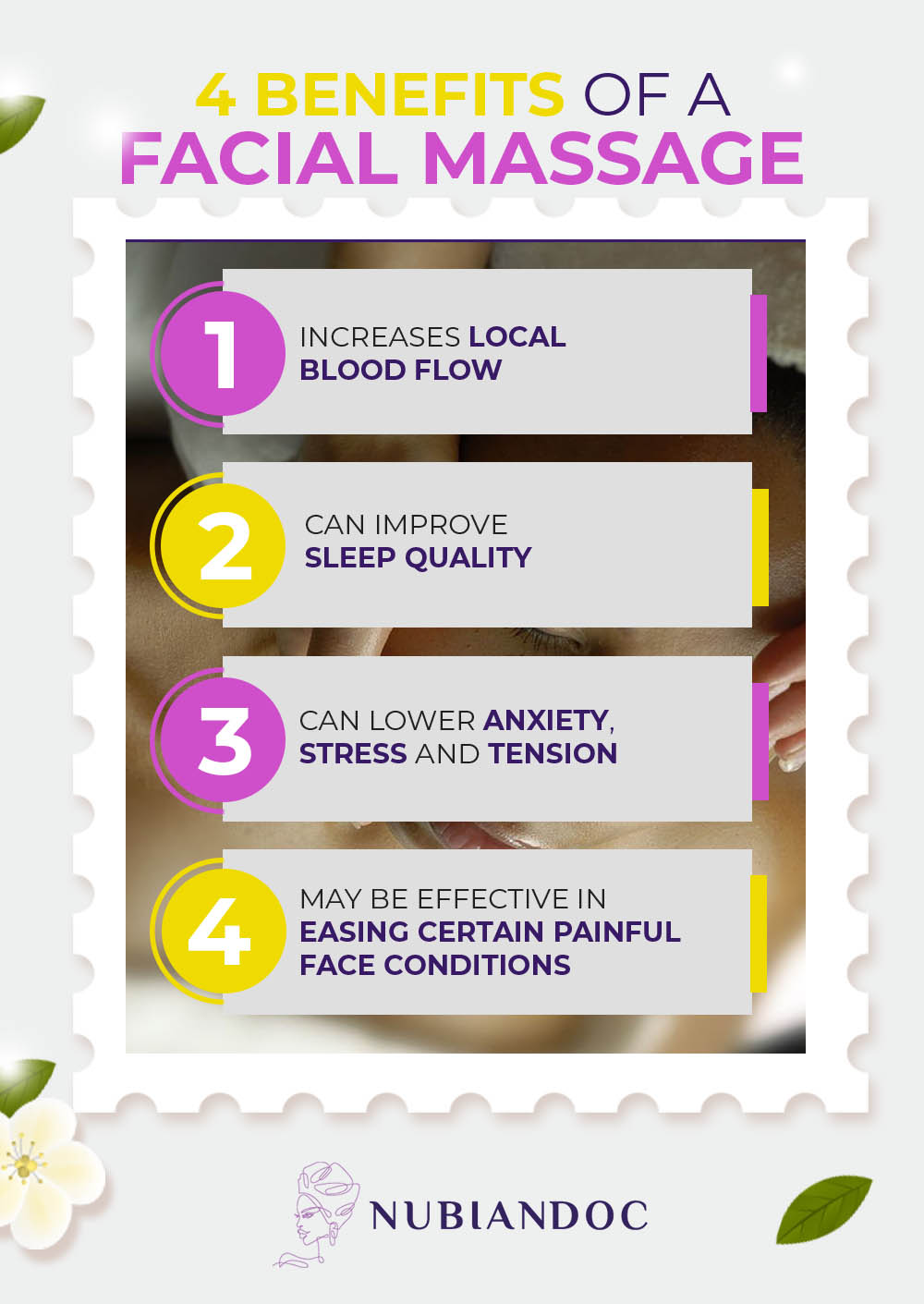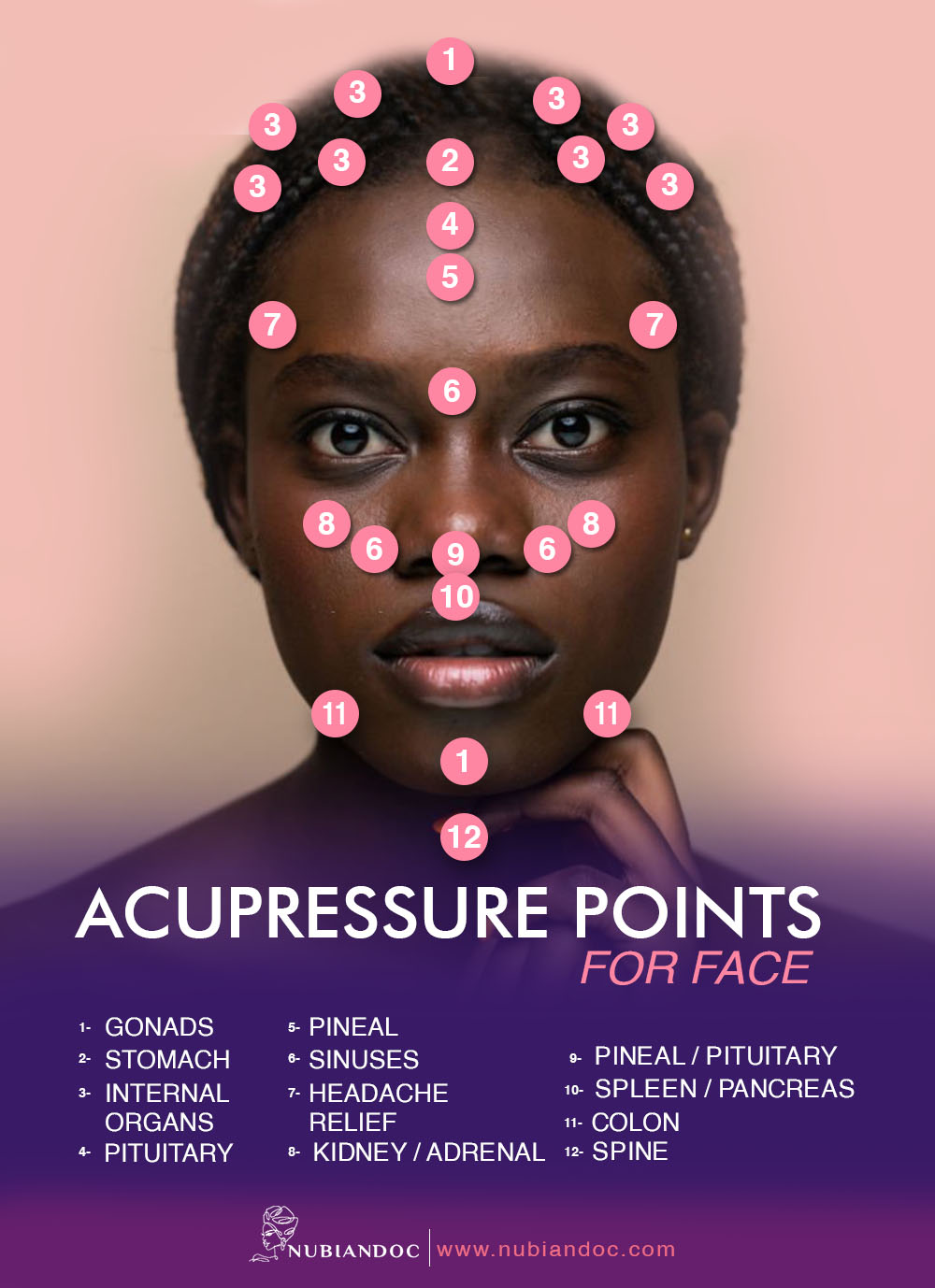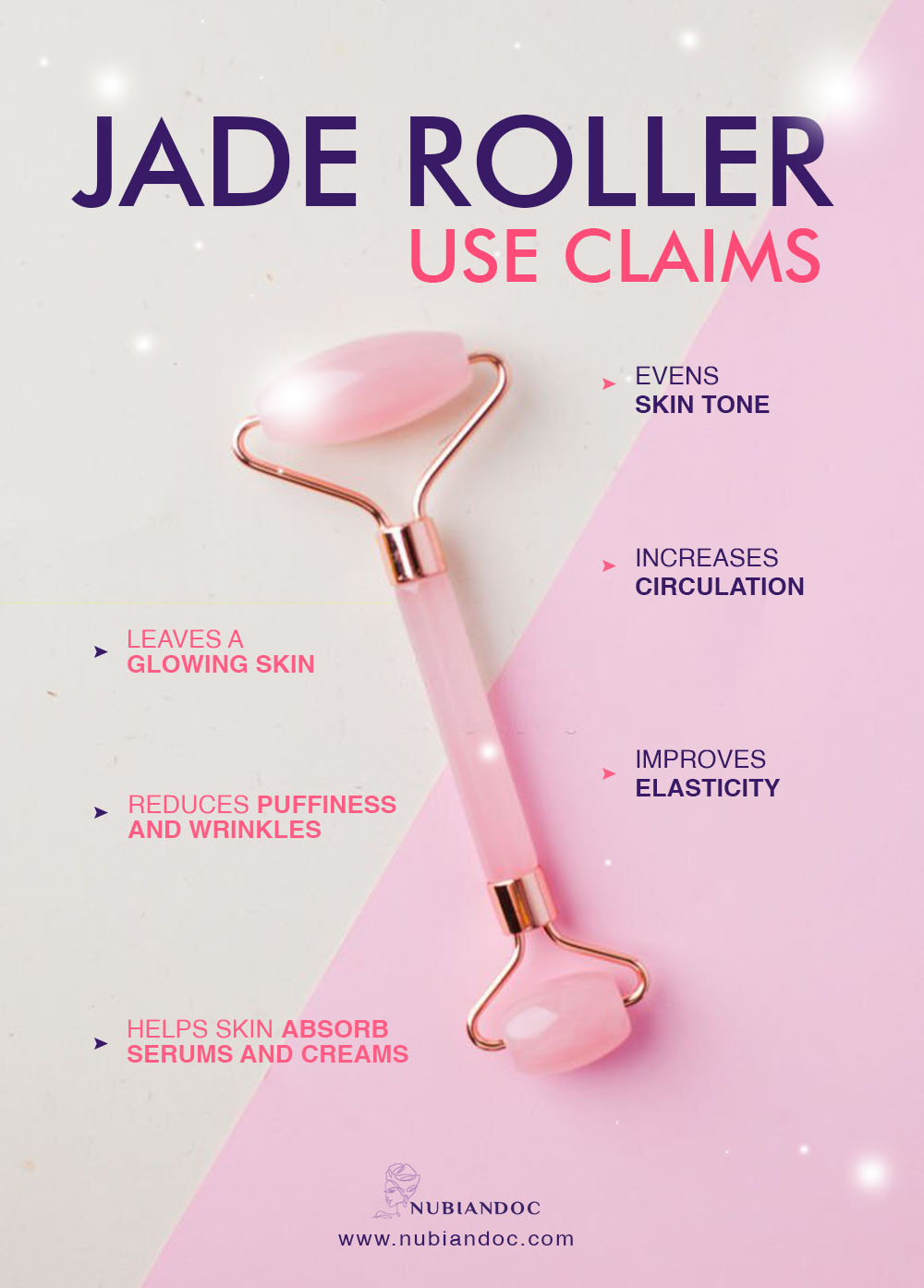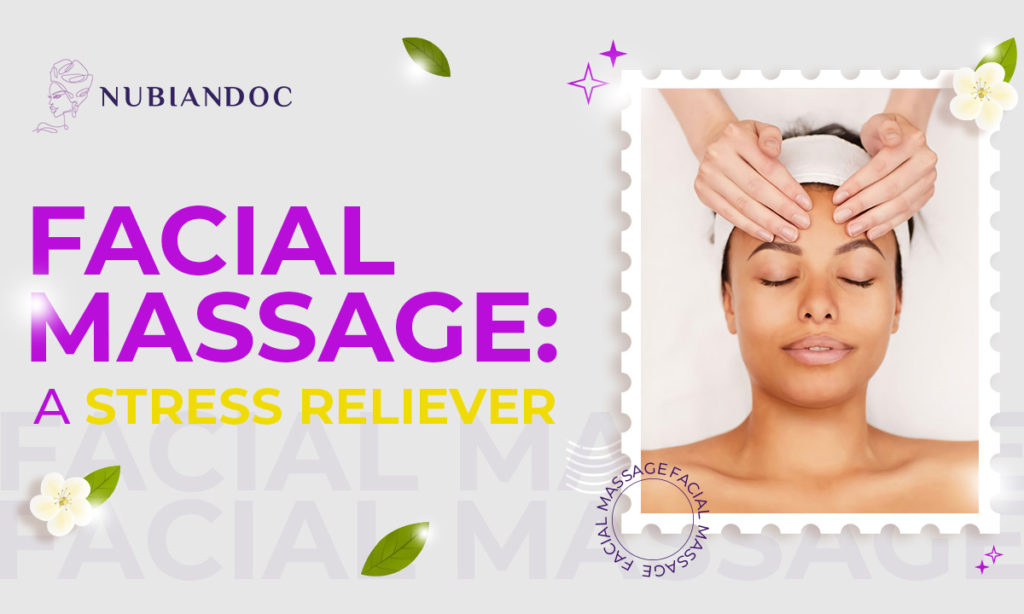Facial massage & types | Facial massage tools | Techniques | Benefits | Facial pressure points | Facial exercises | Stress reliever
Body massage practices have been utilized throughout history as a healing method and has taken numerous forms. The most earliest therapeutic practices go back to ancient China with Acupuncture. This involved pricking the skin with small needles in certain strategic areas to apply gentle pressure. Other forms of massage in history are noted with reflexology among ancient Egypt and deep tissue massage popularized by athletes in Ancient Greece.
Body massage is well known to provide stress and tension relief, improved circulation, and increased flexibility. Facial massage can also be found in ancient times with techniques changing and being passed on through generations. So the facial massage techniques that may be popularized today in aesthetic establishments, spas or on social media are not entirely unique.
Facial massage involves massaging facial muscles and pressure points to relieve stress using your hands or a stone roller. Just a few minutes can help increase blood flow, reduce face puffiness by improving lymphatic drainage, and add a temporary freshness to your appearance.
There are several additional claims floating on social media. That’s why we’re here to help you understand more about it, learn some facial massage techniques and their potential benefits. Continue reading to find out more and if that fancy jade roller is worth the investment.
What is Facial Massage?
Facial massage is the method of massaging the face either by using hands or utilizing a facial massage tool such as a jade roller or a flat gua sha tool. This is combined with the use of cleansing creams, lotions or oils. For many, facial massage is considered an upscale service in spas because of the money and time spent but may also be incorporated into their home face pampering rituals.
Summary: Face massage involves simply massaging different pressure points of the face with either hands or other tools and can be done at home or as a luxury service in a spa.
Types of Facial Massage
Different facial massages with various facial massage techniques are performed either by an expert or completely by yourself.
A few types of “over-hyped” facial massage are as follows:
- Reflexology: Reflexology involves pressing specific facial pressure points which will stimulate other corresponding areas of the body. The claim is that facial reflexology acts as an energy booster and improves the nervous as well as circulatory system.
- Shiatsu: This finger-press technique (only using the fingertips and thumbs) originated from Japan. It is a pressure point and is a stress-reliever. It helps to reduce anxiety, tension and stress. Acupressure is applied to certain points.
- Remedial: Exfoliats are used in this type of massage which gives an instant glow to the skin by removing dead skin cells. The claim is that it also repairs damaged skin.
- Lymphatic: A lymphatic massage reduces puffiness by improving blood circulation and lymphatic drainage.
Facial Massage Techniques
Some direct facial massage spa techniques are listed below:
- Cupping: It is a stress relief massage that involves using small suction cups to stimulate facial muscles and skin, thus improving blood circulation, relieving stress and reported to help in the skin regeneration process. During the treatment the cup is constantly moving across the face.
- Kneading: It involves compressing of soft tissues which improves blood circulation and contour your face giving it a temporary radiant look.
- Effleurage: It is a Swedish massage technique. Light and continuous motion of fingers on facial skin warm up the muscles, relaxes mind and is one of the effective ways to relieve stress.
- Jacquet pinching: Pinching movements and kneading skills are applied in this massage.
- Vibration: There is limited supporting evidence suggesting that vibration may increase production of collagen to strengthen the skin and produce an improvement in fine lines and wrinkles.
| Acupressure Points on & for Face | |
| Facial Acupressure Point | Location |
| BL 1 | Inner corner of the eyes |
| BL 2 | Inner corner of eyebrows |
| GB 14 | Middle of the forehead above center of eyebrows |
| GB 2 | Outer corner of the eyes |
| ST 1 | Below the center of the eyes under the eye bone |
| BL 1 | Inner corner of the eyes |
Summary: There are different types and techniques of facial massage which largely promote increased blood circulation, and may help to temporarily rejuvenate the skin.
Face Massage Benefits
We have the most evidence that massage is helpful for relaxation, reduction of muscle tension and helping with chronic pain. There are however very few studies on the impact of facial massage in skin. Some are promising and others are conflicting. Some of the studies having very few participants and others restricted to small subsection of establishments providing massage services. Thus there are several claims and concepts promoted in the public sphere that don’t have a lot of scientific weight. Some are as follows:
- It is anti-ageing: Toning of face muscles by face massage makes skin look more youthful and radiant. Moreover, it improves blood circulation which aids in the production of collagen that acts as a builder for skin structure.
- It produces soft skin and reduces roughness: Facial massage reduce roughness of skin by making it silky, smooth and soft. It keeps the skin nourished and healthy. Only even toned skin is not enough, smoothness is also essential.
- It reduces the appearance of acne and scars: By boosting circulation and detoxifying the skin.
- Allows better absorption of face products: Proper massage increases absorption of applied products.
- Moreover, it improves skin complexion: The face massage promotes blood circulation, which results in good oxygen flow.
Here is the real deal that’s most clinically relevant:
- It relieves stress: Face massage is one of the best stress relieving activities as it relaxes tension and stiffness in muscles. Relaxing tensed forehead muscles may dampen headaches and jaw clenching issues may also be relieved.
- It acts as a pain reliever: Face massage is a pain reliever. Stress induces pain in forehead, neck, and shoulders. Massage helps in relaxing muscle pain and reduces stiffness of shoulders.
- Sleep restoration: By indirectly encouraging stress and tension reduction we can actually improve our ability to fall asleep and improve sleep quality. Relaxation makes it easier for one to fall asleep. Subsequently relaying the benefits of adequate sleep, including skin repair with immune function in the skin. Much better than taking any medication over the counter for sleep.
Summary: There are some claims about facial massage that have limited weight due to not enough substantial research but from what we know facial massage definitely can be a relaxing practice that helps certain conditions including muscle tension, pain and temporarily reduces puffiness.
How to Relax Facial Muscles At Home?
Facial massage can be easily performed at home. First of all, clean your face and hands. Take a small amount of your favorite moisturizing lotion, oil or cleansing balm for massage so that your fingers can easily roll over the skin. Palm surface can also be used for this purpose.
You can have a massage for 5 minutes or an entire hour. Gentle or firm pressure needs to be applied. Repeat each stroke five times while keeping focus on specific area.
There are various techniques that can be applied. Some of them are as follows:
- Rub your fingers in circular motion into your temples.
- Side face is massaged by palms and fingertips. Start from chin and move up towards your forehead. Then slide your hands back down.
- Exert slight pressure on brow bone with ring finger. Move from inner to outer corner. Perform the same stroke underneath your eyes but be gentle as the skin in this area is thinner.
- Exert pressure at the outer corners of your eyebrows with thumb and then pinch your eyebrows while moving towards inner corner.
- Slightly push finger into center of your eyebrows. Glide up towards hairline and then move towards the temple.
- Exert pressure firmly in between eyebrows for few moments. Keep pressing while making clockwise and anticlockwise movements.
- Press area below cheekbone by using index and middle finger. Move from center of face to temples.
- For a better effect, knuckles can be used to exert pressure on your face. Start from nose and move towards cheeks and ears.
- Pinch center of chin by using thumb and first two fingers.
- Put pressure on jaw by moving your fingers from outside of jaw towards the chin.
- Massage the area under earlobes by keeping movements in a circular motion.
- Press neck with pinky finger. Start from top and then move downward.
- Press inner brow with the ring finger and move towards the outer brow.
- Finger tips can be used for tapping over all the areas of your face. Pinch the fleshy areas for proper massage of your skin.
- Exert firm but gentle pressure for 2 minutes to facial points (at the base of both sides of the nose) for sinus pressure relief.

Facial Pressure Points
Facial pressure points help in reducing congestion, headache, fever, chills, physical pain as well as tension and anxiety. Pressure points also helped in treating paralysis “Bell’s palsy”. According to the 2019‘s trusted research, pressure points were able to reduce pain and fatigue when self-administration of acupressure was done. They are also used in the area of dentistry as a non-invasive approach to lessen the pain. There are many acupressure points located on your face.
Front face points include:
- LI20
- GV26
- Yintang
Side face points include:
- Taiyang
- SJ21
- SJ17
What is Acupressure?
Pressure points on same parts of the body are used to promote optimal health in the process of acupressure. It is basically originated from Chinese medicine and is often mixed with acupuncture- the process in which needles are used to improve health condition. The main purpose of acupressure is to stimulate pressure points which regulate blood and oxygen flow and as a result brings so many benefits to health. It reduces stress and anxiety and is a self-healing process. The pressure applied needs to be mild and gentle because over pressure may cause harm.
Summary: Acupressure is a self-healing way to relieve stress and pain. It should be mild and gentle. Minor ailments can be easily treated with it. If you have serious concerns, approach an expert for appropriate consultation. If you experience pain while executing acupressure, stop the process and reach out to the acupuncturist for proper guidance about pressure points.

How Often Should You Massage the Face?
Gently massage your face for five minutes every day, twice a week or whenever fits your schedule. Professional massage, if one has the means, can be performed once a month.
| Which Oils May be Useful Options for Face Massage? | |
| Skin Type | Oil |
| Dry Skin | Almond, argan & marula oils |
| Oily Skin | Jojoba, grapeseed oils |
| Sensitive Skin | Aloe vera, moringa & chamomile oils |
| Normal Skin | Argan oil |
| Acne-prone skin | Rosehip seed, pomegranate & tea tree oils |
Disadvantages of Facial Massage
Facial massage may harm or negatively affect certain patients with sensitive skin. Additionally, if the massage is done in an incorrect way, too rough or excessive, then bruising and muscle soreness may occur. For people with rosacea, a condition that causes redness and flushing of the face, they should avoid any vigourous facial massage that would encourage increased blood flow or vasodilation. This can lead to a flare and worsen the condition. Also those with moderate to severe inflammatory acne should avoid this service because it may make acne more painful and problematic.

The Bottom Line: Facial Massage
Facial massage is a popular wellness ritual with some positive benefits. There is currently limited data to support some of the additional claims described however it can be an added benefit to self care. Some populations however such as those with sensitive skin, moderate to severe acne, roseaca and other inflammatory skin conditions involving the face should avoid this practice to reduce worsening or flare ups.
If you need guidance related to health and wellness, NubianDoc is here to help you. Our health plans and blogs related to skincare solutions will help you achieve healthy skin and mindful body. Moreover, NubianDoc has blogs related to healthy and tasty recipes that are simple to cook.
Contact us right now and improve your overall health with our 8-week health plan.
Are facial massages beneficial?
Yes, facial massage promotes blood flow and oxygen flow which may improve skin texture and overall appearance temporarily. It can lessen the puffiness of skin and potentially increase the appearance of radiant skin after the massage.
Can massage tone your face?
Unfortunately, there is not enough scientific research to support this claim. If you want to lift your face and keep it contoured, face massage is the best option as it tones muscles and gives your skin youthful appearance by keeping it tightened.
How long should I massage my face?
This is based on individualized interest and the time one has to invest if your doing it at home. Also with that said many clinicians doubt much of the hype since there is not many randomized trials assessing the benefits reported on social media. Well, the time depends solely on what type of skin you have. For oily and acne prone skin, 10 minutes are enough. For normal and dry skin, 20 minutes are good to go. Prolonged time is not recommended as too much stimulation of pressure points can lead to breakouts. Overall, 15-20 minutes are enough to execute this overall process.



